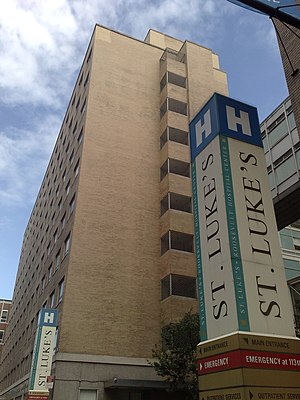| Mount Sinai Morningside | |
|---|---|
| Mount Sinai Health System | |
 Mount Sinai Morningside | |
 | |
| Geography | |
| Location | 1111 Amsterdam Avenue, New York City, New York 10027, United States |
| Coordinates | 40°48′20″N 73°57′42″W / 40.8055°N 73.9618°W |
| Organization | |
| Care system | Private |
| Type | Tertiary teaching hospital |
| Affiliated university | Icahn School of Medicine at Mount Sinai |
| Network | Mount Sinai Health System |
| Services | |
| Emergency department | Level 2 trauma center |
| Beds | 495 |
| History | |
| Opened | 1850 |
| Links | |
| Website | www |
| Lists | Hospitals in the United States |
| Other links | Hospitals in Manhattan |
Mount Sinai Morningside | |
New York City Landmark No. 2113 | |
| Built | 1896–1928 |
| Architect | Ernest Flagg |
| Architectural style | French Renaissance Revival |
| NRHP reference No. | 100003934 |
| NYCL No. | 2113 |
| Significant dates | |
| Added to NRHP | May 20, 2019 |
| Designated NYCL | June 18, 2002 (Plant and Scrymser Pavilions only)[1] |
Mount Sinai Morningside, formerly known as Mount Sinai St. Luke's, is a teaching hospital located in the Morningside Heights neighborhood of Manhattan in New York City. It is affiliated with the Icahn School of Medicine at Mount Sinai and the Mount Sinai Health System, a nonprofit hospital system formed by the merger of Continuum Health Partners and the Mount Sinai Medical Center in September 2013. It provides general medical and surgical facilities, ambulatory care, and a Level 2 Trauma Center, verified by the American College of Surgeons.[2] From 1978 to 2020, it was affiliated with Mount Sinai West as part of St. Luke's–Roosevelt Hospital Center.
Mount Sinai Morningside is the primary provider of health care serving the neighborhoods of the Upper West Side and western Harlem. It operates 21 clinics and as of 2020, is nationally ranked #23 for Diabetes and Endocrinology, and #25 for Nephrology by U.S. News & World Report. As of 2020, Arthur A. Gianelli is President[3] and Brian Radbill is Medical Officer and Senior Vice President of Medical Affairs.[4][5]
The structure was erected in 1896 as St. Luke's Hospital, and was designed by Ernest Flagg. Several additions were built in the early 20th century, and some of the original pavilions have been demolished. Parts of the facility have been designated as an official New York City landmark, and the remaining pavilions of the original hospital are listed on the National Register of Historic Places.
- ^ Cite error: The named reference
NYCL (2002) p. 1was invoked but never defined (see the help page). - ^ "Trauma Centers". American College of Surgeons. Archived from the original on May 15, 2020. Retrieved February 7, 2020.
- ^ West, Melanie Grayce (February 7, 2020). "St. Luke's Hospital Rebrands as Mount Sinai Morningside After $250 Million Overhaul". Wall Street Journal. ISSN 0099-9660. Archived from the original on February 8, 2020. Retrieved February 7, 2020.
- ^ admin (April 2019). "Arthur Gianelli – President of Mount Sinai St. Luke's". Morningside Area Alliance. Archived from the original on February 7, 2020. Retrieved February 7, 2020.
- ^ "Patients more satisfied when doctors treat fewer people". Reuters. April 13, 2018. Archived from the original on February 7, 2020. Retrieved February 7, 2020.